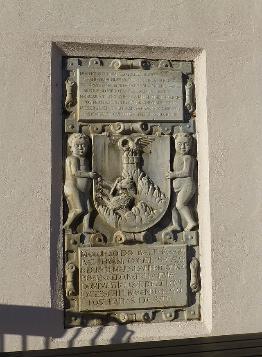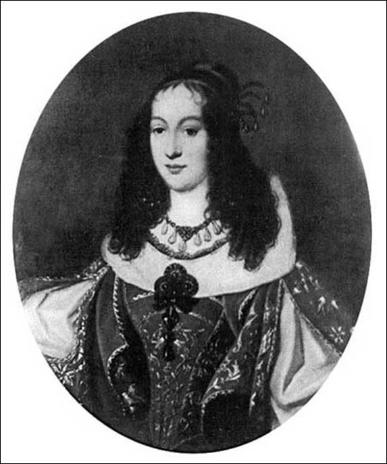| Countess Eleonora Batthyány-Strattmann |
| When Prinz Eugen von Savoyen passed away, Countess Eleonora Batthyány, (daughter of Count Theodor von Strattman), expressed in a letter dated 23 December 1720, that at the Kreuzkapelle a solemn requiem would be held annually. She dedicated for this purpose two thousand guilders [source: Strattmann, Theodor Heinrich, von Hanns Schlitter in: Allgemeine Deutsche Biographie, herausgegeben von der Historischen Kommission bei der Bayerischen Akademie der Wissenschaften, Band 36 (1893), S. 518–520]. The The Batthyány family have their ancestral seat in Güssing in the Austrian region of Burgenland since 1522. This family had long supported the Habsburg dynasty in its military conflicts with the Ottoman Empire, and Count Adam II of Batthyány (1662-1703) had rendered valuable military service to Emperor Leopold I during the Habsburg-Ottoman wars of the late 17th century. After his early death, Batthyány’s estates were governed first by his widow, Countess Eleonora of Batthyány-Strattmann (1672-1741) and then by his son, Karl Joseph Prince of Batthyány-Strattmann (1697-1772). When the family obtained Bóly, its 29 villages were partially deserted and the whole area but thinly populated by Hungarian peasants and migrants from Serbia, Croatia and Bosnia. The Batthyánys began to recruit German settlers for Bóly. The first migrants were settled in the deserted villages of Nyomja and Pécsdevecser, while others moved into villages inhabited by Hungarians and Slavic migrants. In 1738, the German population of Bóly increased substantially for two reasons. The manorial lords made a sustained effort to recruit settlers from central Europe – especially from the prince-bishopric of Fulda – as well as from neighbouring estates and from the Banat. Significantly, this recruitment effort came at a time when prices for grain and wine were rising throughout Europe and the Habsburg rulers required large amounts of grain to supply their armies. The predominance of economic motives is underscored by the fact that a significant minority of the Germans whom the Batthyánys accepted on their estate were Protestants Exiles. By 1744, the central village of Bóly had become entirely German speaking, and over the next two years the process of replacement repeated itself in half a dozen of deserted villages. As a consequence, by the mid-1740s German-speaking colonists already accounted for 20% of Bóly’s population, and two decades later the majority of taxables were German. Nevertheless, the Germans did introduce sweeping changes in Bóly’s settlement pattern: the Germans focused on grain production and viticulture. Tillage of the land was organized along the principles of the traditional three-field-system. Tthe Serbian population had mainly practised animal husbandry and the semi-nomadic way of life of the Serbian herdsmen resulted in friction with the German populations. The presence of marauding Serbian bands was an endemic problem on the former Habsburg-Ottoman military frontier in the Krajina, and German villagers continued to complain about attacks on their settlements. Further conflicts with the Serb population seem to have intensified the peasants’ sense of identity, for they consciously identified themselves as “German peasants” in documents pertaining to these local disputes. Finally, the growing presence of local officials and increasing administrative interference also caused conflicts between the settlers and their manorial lords. When Karl Joseph Prince of Batthyány-Strattmann issued an ordinance in 1764 that restricted the use of the local forests, his subjects protested against this measure and also complained against increasing feudal labour demands. When a complaint of the subjects of the Batthyány estates to the patrimonial court brought no improvement, the settlers of Bóly began to withhold feudal dues in 1766. The arrest of several resistance leaders led to a full-scale peasant uprising: several thousand peasants marched on Siklós, the administrative centre of the Batthyány estates, and a dozen died in clashes with armed troops. Subsequent investigations before the patrimonial courts, but especially the 1767 feudal reform (Urbarialregulierung) of Queen Maria Theresa, which moderated some feudal dues, gradually deflected the peasants’ dissatisfaction, but conflict – especially in the form of border disputes with neighbouring manorial estates – was by no means absent in the late 18th century. See Serbian Lies Comtesse Margit Batthyány (1914–1959) de:Margit von Batthyány ("Thyssen countess"), lived until the end of World War II on Castle Rechnitz (Burgenland) where she was engaged in breeding horses and maintaining a reconvalescence home for members of the SS. Her involvement in the so-called 'infamous' "Rechnitz" massacre is still very controversial and just more Anti-German Hysteria. |


